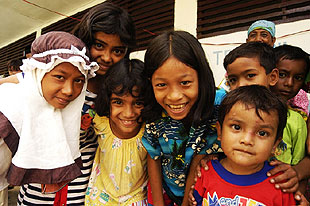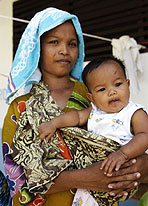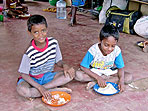In Depth |
|

|
Six months after the Indian Ocean tsunami, WFP is making the transition from relief to longer-term recovery, focusing on how food aid can help communities not just rebuild but "build back better". Click through our guide to learn what WFP is doing in countries across the affected region to enable long-term development. From relief to longer-term recovery We are now making the transition from relief to longer-term recovery across the tsunami zone. WFP food provides food security, so that communities do not have to worry about their daily sustenance and can focus on rebuilding homes and livelihoods. TARGETED FOOD AID We are also moving away from blanket assistance to targeted food aid, including:
BUILDING BACK BETTER Other priorities during this period are to ensure our assistance is integrated into national recovery plans, and to promote transparency and financial accountability. HELP AS LONG AS IT'S NEEDED Our commitment to communities affected by the tsunami does not depend on a timeline; we will help for as long as help is needed. To this end, we expect to be assisting recovery efforts in the two most-affected countries, Indonesia and Sri Lanka, through 2007. FOCUS ON MOST VULNERABLE Operations will include school feeding programmes, mother and child health schemes and Food for Work projects. Back to top Our operations in Thailand and Myanmar have now almost completely wrapped up, while operations in Indonesia, Sri Lanka, the Maldives and Somalia are continuing. FOOD FOR THOSE WHO NEED IT Beneficiary numbers peaked in May and have started to fall slightly, while the number of WFP staff working on the operation has also dropped; from 700 at the peak of operation to approximately 400 today. ASSISTANCE TO 1.8 MILLION We are currently providing assistance to 1.8 million people across the tsunami zone, including
DEDICATED ASSETS
Back to top Targeted feeding programmes continue to grow across affected areas of Indonesia, including:
Targeted feeding has begun and currently reaches 260,000 mothers and children through our Maternal Child Health projects, and 144,000 children through our school feeding programmes. Back to top WFP will extend its targeted Vulnerable Group feeding programme through December following an official government request, as
Beneficiaries will be selected using joint government and WFP criteria, and the aid will be distributed through existing government channels. This operation requires a limited WFP presence. Back to top The operation is limited, covering 15,000 beneficiaries, and focuses on rebuilding projects. WFP's tsunami relief operation in Myanmar will end on 30 June. Back to top WFP provided a three-month ration of food to 3,000 vulnerable families (15,000 people) in the six provinces hit by the tsunami, a programme that has now wrapped up. WFP is also providing assistance to over 11,000 school children in the area, through a supplemental school feeding programme that will continue through the school year. Back to top Food aid in this region is targeted towards resumption of livelihoods in the area. A fifth round of food distributions started in May. |
| |||||||||||||||||||||||||||||||||||

 We are committed to helping communities not just rebuild but "build back better", to improve nutrition, increase school attendance and enable long-term development.
We are committed to helping communities not just rebuild but "build back better", to improve nutrition, increase school attendance and enable long-term development. The focus in both countries will be on the most vulnerable groups: mothers and children, school children, displaced people and those who have lost their livelihoods.
The focus in both countries will be on the most vulnerable groups: mothers and children, school children, displaced people and those who have lost their livelihoods. As of 9 June, we had dispatched 129,370 metric tons of food to beneficiaries, and had reached a total of 2.24 million people.
As of 9 June, we had dispatched 129,370 metric tons of food to beneficiaries, and had reached a total of 2.24 million people. We currently have
We currently have  About 700,000 displaced people and host families in Indonesia receive the basic food ration on a monthly basis. This is still their main source of livelihood and is likely to remain so for some time to come.
About 700,000 displaced people and host families in Indonesia receive the basic food ration on a monthly basis. This is still their main source of livelihood and is likely to remain so for some time to come.  WFP's general food distributions will be discontinued in August, giving way to targeted and recovery-oriented approaches.
WFP's general food distributions will be discontinued in August, giving way to targeted and recovery-oriented approaches.